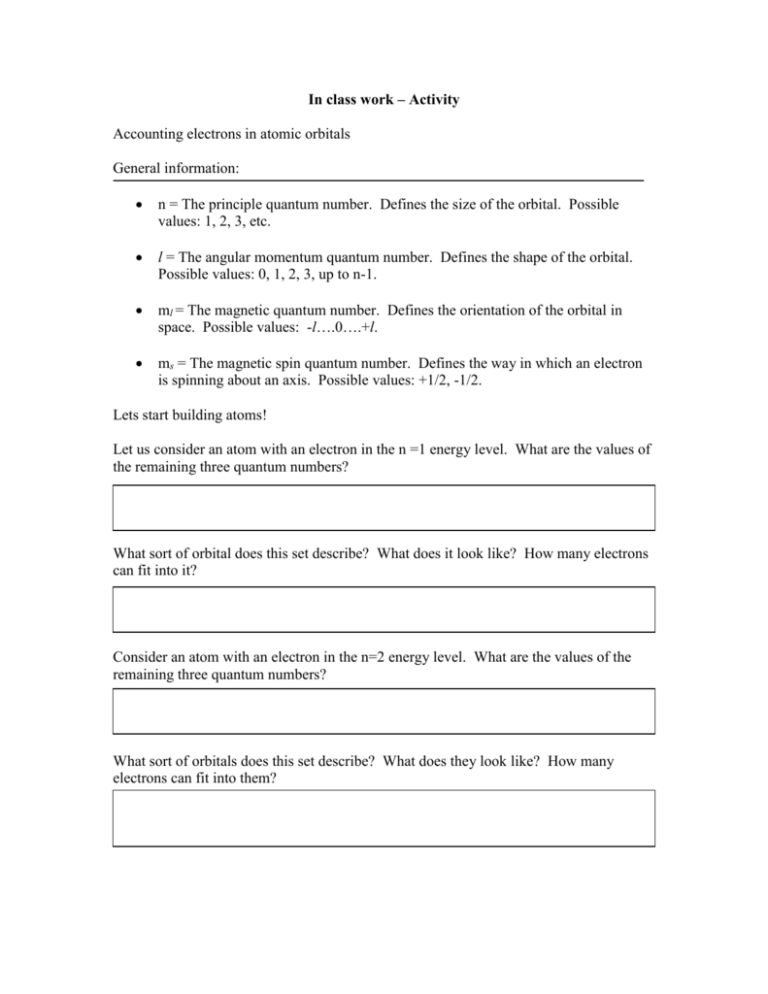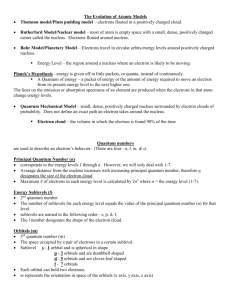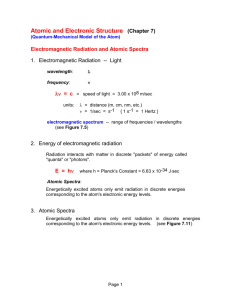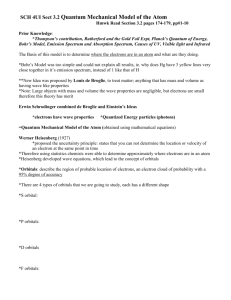WORD
advertisement

In class work – Activity Accounting electrons in atomic orbitals General information: n = The principle quantum number. Defines the size of the orbital. Possible values: 1, 2, 3, etc. l = The angular momentum quantum number. Defines the shape of the orbital. Possible values: 0, 1, 2, 3, up to n-1. ml = The magnetic quantum number. Defines the orientation of the orbital in space. Possible values: -l….0….+l. ms = The magnetic spin quantum number. Defines the way in which an electron is spinning about an axis. Possible values: +1/2, -1/2. Lets start building atoms! Let us consider an atom with an electron in the n =1 energy level. What are the values of the remaining three quantum numbers? What sort of orbital does this set describe? What does it look like? How many electrons can fit into it? Consider an atom with an electron in the n=2 energy level. What are the values of the remaining three quantum numbers? What sort of orbitals does this set describe? What does they look like? How many electrons can fit into them? Consider an atom with an electron in the n=3 energy level. What are the values for the remaining three quantum numbers? What sort of orbitals does this set describe? What does they look like? How many electrons can fit into them? There is a trend arising here. Every energy level contains _____________kinds of orbitals. Every energy level can contain ____________ total orbitals. Every energy level can contain _______________ electrons. Many electron atoms As atoms gain electrons, they need to exist in a space that is defined by a quantum mechanical wavefunction. Which means, that it must fit into some kind of orbital. He for example in the n=1 state has two electrons, both of which are held in the s shaped orbital of the first energy level. Therefore the electron configuration for He is He = 1s2 If helium is given one more electron, to make He-, there is no room for the extra electron in that 1s orbital. Therefore a second orbital must be created with a higher energy (n=2). This orbital is the 2s orbital. The electron configuration for an atom with 3 electrons is He- = 1s22s1 Which is also the same for the neutral lithium (Li) atom. Li has 3 electrons as well (it is considered to be isoelectronic with He-). Two of them are in the lowest, most stable orbital, the n=1 s orbital. The next one is placed in the next available orbital which is the n=1 s orbital. This principle of building up from the most stable, lowest energy, orbital is called the Aufbau principle. What is the electron configuration for Be? If Be is given an extra electron to make Be-, one will notice that there is no room for the extra electron in the 2s orbital since it already has 2 electrons in it. In the second energy level, there are 2 kinds of orbitals available. The ‘s’ shaped when l=0 and the ‘p’ shaped when l=1. Therefore the extra electron will have to go into a p shaped orbital. Making the electron configuration Be- = 1s22s22p1 Write the electron configurations for the following atoms: C, N, O, F, Ne, Ne-, Na, Mg Degenerate orbitals are two or more orbitals that are distinct yet have the same energies. For example the p shaped orbitals have three possible arrangements in space (since their magnetic quantum number ml has three values). Each of these orbitals have the same amount of energy. So how do electrons get put into them? Boron for example has one electron in the p orbitals. When we look at C, which has two electrons, where does the second one go? A or B? A B Thinking of it in terms of repulsion, B is clearly the way to go. Electrons are negatively charged, and an orbital is just an area in space. It is more energetically favorable for electrons to be in entirely different spaces than for them to share a space and repel one another. This is known as Hund’s Rule. Keep filling atomic orbitals The Aufbau principle tells us that electrons will fill lower energy orbitals before they fill higher energy orbitals. This takes on a special significance as we get a little bit deeper into the periodic table. Consider the following energy diagram This diagram shows relative energies for available orbitals. Since we know that electrons fill the lowest energy orbitals first, using this diagram, we can determine the electron configuration for nearly any element on the periodic table. One important thing to notice is that there is some overlap between energy levels. For example the 3d orbitals are higher in energy than the 4s orbitals, but lower in energy than the 4p orbitals. Which means, they get filled before the 4p orbitals. Picking an element at random Br The electron configuration would be an account of where all of its 35 electrons are. Br = 1s22s22p63s23p64s23d104p5 All of the superscripts account for all of the electrons. If this was done correctly, they should sum up to 35. Write electron configurations for each of the following atoms P, Zr, Fe, Ca, S, Ba, Cl, Al, Sr







